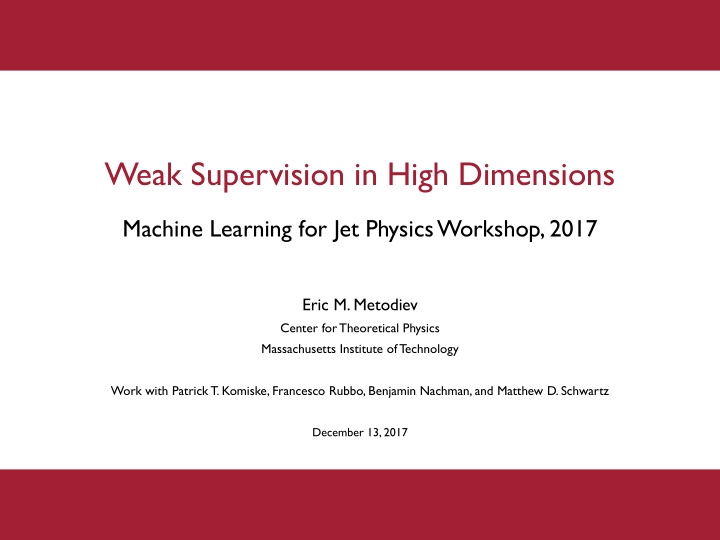



Weak Supervision in High Dimensions Machine Learning for Jet Physics Workshop, 2017 Eric M. Metodiev Center for Theoretical Physics Massachusetts Institute of Technology Work with Patrick T. Komiske, Francesco Rubbo, Benjamin Nachman, and Matthew D. Schwartz December 13, 2017
Why learn from data? Weak Supervision in HEP Lessons from High Dimensions
Simulation vs. Data Quark/Gluon Discrimination Using two features: width and ntrk. Signal (Q) vs. Background (G) likelihood ratio [ATLAS Collaboration, arXiv: 1405.6583] Simulation Data
Mixed Samples Data does not have pure labels, but does have mixed samples! Some caveats apply. See e.g. P. Gras, et al. , arXiv: 1704.03878 𝑞 𝑁 𝑏 (𝑦) = 𝑔 𝑏 𝑞 𝑇 𝑦 + 1 − 𝑔 𝑏 𝑞 𝐶 𝑦 Fractions of quark and gluon jets studied in detail in: J. Gallicchio and M.D. Schwartz, arXiv: 1104.1175
Mixed Samples Data does not have pure labels, but does have mixed samples! Some caveats apply. See e.g. P. Gras, et al. , arXiv: 1704.03878 𝑞 𝑁 𝑏 (𝑦) = 𝑔 𝑏 𝑞 𝑇 𝑦 + 1 − 𝑔 𝑏 𝑞 𝐶 (𝑦) Criteria to use Weak Supervision: Sample Independence : The same signal and background in all the mixtures. Different Purities : 𝑔 𝑐 for some 𝑏 and 𝑐 . 𝑏 ≠ 𝑔 (Known fractions) : The fractions 𝑔 𝑏 are known.
Why learn from data? Weak Supervision in HEP Lessons from High Dimensions
Learning from Label Proportions (LLP) (LoLiProp?) [L. Dery, et al. , arXiv: 1702.00414] Q/GWS with 3 inputs works [L. Dery, et al. , arXiv: 1702.00414] 𝑔 𝑔 1 2 𝑂 𝑏 𝑏 , 1 ℓ LLP = ℓ 𝑔 ℎ(𝑦) 𝑂 𝑏 𝑏 𝑗=1 ℓ 𝑁𝑇𝑋 , ℓ 𝐷𝐹 , …
Classification Without Labels (CWoLa, “koala”) [EMM, B. Nachman, and J. Thaler, arXiv: 1708.02949] [T. Cohen, M. Freytsis, and B. Ostdiek, arXiv: 1706.09451] See also: [G. Blanchard, M. Flaska, G. Handy, S. Pozzi, and C. Scott, arXiv:1303.1208 ] Q/GWS with 5 inputs works [EMM, B. Nachman, and J. Thaler, arXiv: 1708.02949] No label proportions needed during training! Smoothly connected to the fully supervised case as 𝑔 1 , 𝑔 2 → 0,1 Note : Need small test sets with known signal fractions to determine the ROC.
Why learn from data? Weak Supervision in HEP Lessons from High Dimensions
Convolutional Net for QG CNN as in: P. Komiske, E. Metodiev, M.D. Schwartz, arXiv:1612.01551 33 x 33 = 1089 inputs, 2R=0.8 size in (𝑧, 𝜚) Only used pT -channel images
Defaults Jet Generation Z + q/g Pythia 8.226, 𝑡 = 13 TeV R=0.4 anti-kT central jets pT in [250 GeV, 275 GeV] q g Artifical q/g mixtures CNN Training Keras and TensorFlow 300k/50k/50k train/test/val data Mixed sample fractions 𝑔 1 = 0.2 and 𝑔 2 = 0.8 Batch size 400 for CWoLa and 4k for LLP ELU activation and cross-entropy loss functions Training until validation accuracy failed to improve for 10 epochs Repeat each training 10x for statistics
Training on mixed samples Q/G weak supervision with jet images works! Lesson should be true for complex models more generally. PRELIMINARY Better
What about naturally mixed samples? Z + jet: dijets: 𝑔 𝑟 = 0.88 𝑔 𝑟 = 0.37 Restrict to artificially mixed samples to have fine control of the fractions.
Purity and Number of Data Full Supervision Two mixed samples: 𝑔 PRELIMINARY 1 , 1 − 𝑔 1 Purity/Data plot can characterize tradeoffs in a weak learning method
Batch Size and Training Time Batch size PRELIMINARY Usual parameter for CWoLa Need large batch size for LLP Batch Size > 1000 𝑂 𝑏 𝑏 , 1 ℓ LLP = ℓ 𝑔 ℎ(𝑦) 𝑂 𝑏 𝑏 𝑗=1 time/epoch increases # of epochs increases
Loss and Activation Functions LLP: PRELIMINARY ELU activations help significantly over ReLU activations. Weak crossentropy loss helps over weak MSE loss. Include the softmax in the loss (not model) to avoid underflow.
Conclusions Weak supervision methods work for training complex classifiers. Have several different methods that utilize different information. Which to use depends on the specific application. LLP: Requires specialized loss functions and care Utilizes fraction information Can make use of multiple fractions CWoLa: Can use with any fully supervised technique Does not require fraction information Only works with two mixed samples
The End Why learn from data? Weak Supervision in HEP Lessons from High Dimensions
Multiple Mixture Fractions PRELIMINARY LLP
Recommend
More recommend